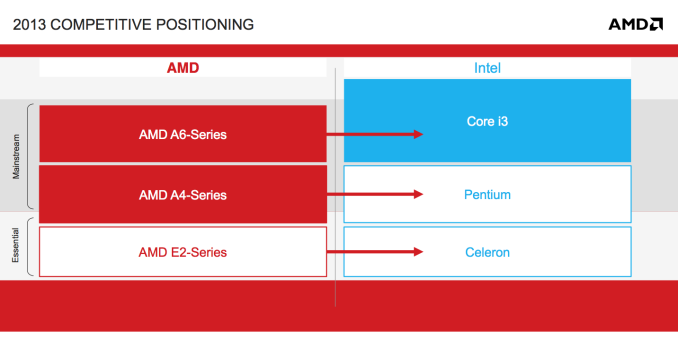The AMD Kabini Review: A4-5000 APU Tested
by Jarred Walton on May 23, 2013 12:00 AM ESTKabini: Competing in the Evolving Marketplace
Prior to the onslaught of Android tablets and the launch of Windows 8, I was pretty much done with Atom and Brazos—they simply didn’t provide enough performance to make them pleasant devices for me to use. What was rather anemic hardware for Windows Vista/7 starts to look much more palatable with the new OS, and Android on such a chip can run extremely well. AMD has Temash for that audience, but I suspect we’ll at least see some 15W Kabini tablets/hybrids at some point, and they should stack up quite well against the competition in terms of performance and features. That’s the real takeaway from today’s launch, and it shows that AMD is keen to carve out a market niche separate from the traditional desktop and laptop PCs.
In terms of the normal Windows experience, Kabini doesn’t make too many waves. Yes, it’s faster than any current Atom or Brazos laptop, and Windows runs reasonably well all things considered, but there are still applications where Kabini falls short. That's the problem with competing in the good enough part of the computing spectrum—everyone has a different definition of what's good enough.
CPU performance is appreciably better than anything Bobcat or Atom based at this point. If you're ok with Clover Trail, then Kabini will feel really quick. The big Ivy Bridge cores still maintain a significant performance advantage, but presumably Kabini's offer is that you can find it in an Ultrabook-like system but at a much more reasonable pricetag. If that ends up being the case, I suspect many would choose form factor over extra CPU performance. So much of Kabini's success will be tied to what OEMs do with the parts. It's unfortunate that AMD doesn't have any Kabini APUs with Turbo Core working as I suspect that could do wonders for further driving single threaded performance.
On the graphics front, Kabini's Radeon HD 8330 is stuck between a rock and a hard place. It's significantly faster than what we had with Brazos (and lightyears ahead of what you get with Clover Trail), but not faster than Intel's HD 4000 which we viewed as the minimum acceptable level of performance for processor graphics upon its introduction. However, if you're playing older titles, or when faced with more tablet-like 3D workloads, Kabini's GPU should do very well.
On the power front, Kabini is great. In our tests we found much better battery life than Brazos and even better battery life than 17W Ultrabook-class Ivy Bridge parts. The days of AMD being associated with poor battery life are long gone. Kabini manages compelling battery life and better performance than Brazos, which is exactly what AMD needs. Given how successful Brazos was (almost 50M units shipped), Kabini seems to have the right recipe.
The real question for me is what sort of laptops and devices we’ll see when manufacturers release Kabini into the wild. The prototype laptop is really weak on some areas I care about—the keyboard and touchpad just don’t impress, and build quality is flimsy at best—but what it does have is a great LCD for what will hopefully be a budget-friendly laptop. Give me a reasonable Ultrabook-style chassis (or maybe a dockable tablet) with Kabini and a decent quality 1080p touchscreen and do it at the right price and there are plenty of people that will jump at the offer.











130 Comments
View All Comments
Gigaplex - Thursday, May 23, 2013 - link
I don't think these chips are hUMA yet.silverblue - Saturday, May 25, 2013 - link
I don't think we're even getting that until Kaveri, unless the console setups feature it.HalloweenJack - Thursday, May 23, 2013 - link
why are you including a cpu which isn't in the same market? `hey here's a good AMD APU , but were going to ignore that and put an IB in the graphs for lol factor cause its far better and we don't want AMD to look good for once`. seriously anandtech.haukionkannel - Thursday, May 23, 2013 - link
This could be really nice in 7" to 8" windows8 tablet! Faster than atom, cheap and eat less power. Finally one can get surface pro tablet near 300-400$ and still get resonable good performance...Yeah Haswell ULV will be much faster, but then the cost will be near 1000$ for tablet, I am not so interested in that alternative!
Fanny how AMD can beat intel in ultra portable devices! We really need a new version of Atom to compete with this. Luckily it is coming so we will see some old fachioned competition in that sector! Competetion is good! We just have to see what has happened in highend CPU and see stalling situation in there...
whyso - Thursday, May 23, 2013 - link
This is using way more power than the atom z2760.Gaugamela - Thursday, May 23, 2013 - link
Go check benchmarks for Temash.whyso - Thursday, May 23, 2013 - link
Its still using about twice as much power.z2760 tdp is 1.7-3 watts.
axien86 - Thursday, May 23, 2013 - link
AMD Jaguars destroys Atom Z2760 in performance while costing the same. Consumers win.
silverblue - Saturday, May 25, 2013 - link
With Toms, they were told by AMD that Kabini should be compared to stuff within the same price bracket, hence the Pentium and i3 in their review.Here, AT doesn't have comparable hardware (they don't get sent it).
CajunArson - Thursday, May 23, 2013 - link
Dude.. AMD put together a laptop and shipped it to Anandtech for benchmarking. How is it Anandtech's fault that AMD intentionally chose not to put dual-channel memory into a prototype notebook that it built itself? Instead of blaming Anandtech for being "biased," maybe we should be looking at why AMD chose not to equip its own prototype with dual channel memory?